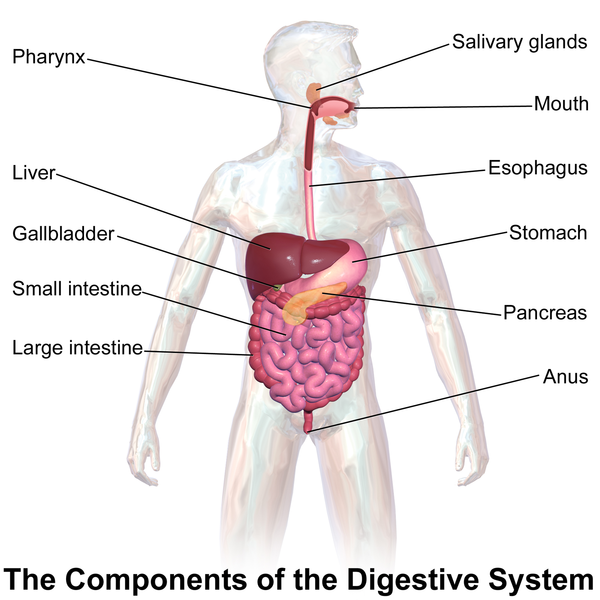
Pancreas is located just _______the stomach.
A. Below
B. Upon
C. Right side
D. Left side
Answer
471.3k+ views
Hint:-Pancreas is surrounded by other organs like liver, small intestine and spleen. Liver surrounds the pancreas from the right side while the spleen and small intestine surrounds it from the posterior part.
Complete step-by-step solution:-Pancreas is a mixed gland in our body. It develops from endoderm.
It is the organ situated in the upper left side of the abdominal cavity, between the limbs of ‘C’ shaped Duodenum, below the stomach.

So, the correct option is (a)Below.
ADDITIONAL INFORMATION:
- The exocrine part is made of numerous Acini. Acini is a group of secretory cells surrounding a cavity. Each acini is lined by pyramidal shape cells, secreting enzymes of pancreatic juice.
- Each acini opens into a pancreatic duct. Many pancreatic ductules combined to form the main pancreatic duct (the duct of Wirsung). The main pancreatic duct joins with the common bile duct to form hepatopancreatic ampulla which opens into duodenum. This opening is guarded by Sphincter of Oddi.
- In the endocrine part, small groups of endocrine cells are found between the acini and are called islet of Langerhans. These islets secrete glucagon, insulin, somatostatin and pancreatic polypeptide.
- The Alpha cells in the pancreas secrete glucagon which is a hyperglycemic hormone on the other hand the Beta cells of the islet of Langerhans secrete insulin which is a hypoglycemic hormone. These two hormones maintain the blood sugar level in our body.
Note:-
- Though Pancreas is a mixed gland, its 99% part is exocrine and only 1% part is endocrine.
- Pancreatic secretion of enzymes is stimulated by Cholecystokinin and Acetyl-choline while bicarbonate is stimulated by secretin.
Complete step-by-step solution:-Pancreas is a mixed gland in our body. It develops from endoderm.
It is the organ situated in the upper left side of the abdominal cavity, between the limbs of ‘C’ shaped Duodenum, below the stomach.

So, the correct option is (a)Below.
ADDITIONAL INFORMATION:
- The exocrine part is made of numerous Acini. Acini is a group of secretory cells surrounding a cavity. Each acini is lined by pyramidal shape cells, secreting enzymes of pancreatic juice.
- Each acini opens into a pancreatic duct. Many pancreatic ductules combined to form the main pancreatic duct (the duct of Wirsung). The main pancreatic duct joins with the common bile duct to form hepatopancreatic ampulla which opens into duodenum. This opening is guarded by Sphincter of Oddi.
- In the endocrine part, small groups of endocrine cells are found between the acini and are called islet of Langerhans. These islets secrete glucagon, insulin, somatostatin and pancreatic polypeptide.
- The Alpha cells in the pancreas secrete glucagon which is a hyperglycemic hormone on the other hand the Beta cells of the islet of Langerhans secrete insulin which is a hypoglycemic hormone. These two hormones maintain the blood sugar level in our body.
Note:-
- Though Pancreas is a mixed gland, its 99% part is exocrine and only 1% part is endocrine.
- Pancreatic secretion of enzymes is stimulated by Cholecystokinin and Acetyl-choline while bicarbonate is stimulated by secretin.
Recently Updated Pages
Master Class 12 Economics: Engaging Questions & Answers for Success

Master Class 12 Maths: Engaging Questions & Answers for Success

Master Class 12 Biology: Engaging Questions & Answers for Success

Master Class 12 Physics: Engaging Questions & Answers for Success

Master Class 12 Business Studies: Engaging Questions & Answers for Success

Master Class 12 English: Engaging Questions & Answers for Success

Trending doubts
Which are the Top 10 Largest Countries of the World?

Differentiate between homogeneous and heterogeneous class 12 chemistry CBSE

Draw a labelled sketch of the human eye class 12 physics CBSE

What is the Full Form of PVC, PET, HDPE, LDPE, PP and PS ?

What is a transformer Explain the principle construction class 12 physics CBSE

What are the major means of transport Explain each class 12 social science CBSE




